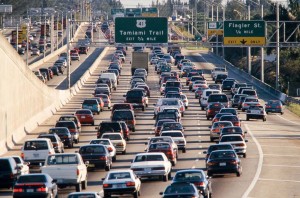The good news, reports the University of Michigan Transportation Research Institute, is that today’s cars are more fuel-efficient than ever – the window sticker on the average vehicle sold in February climbing to 24.5 mpg.
The bad news? Motorists are driving longer distances, and with fewer people in their vehicles, sharply undercutting the improvements in vehicle fuel economy.
In a somewhat complex formula incorporating fuel economy, distance driven and the number of passengers traveling in each vehicle, the study concludes that fuel economy – per person traveling – has barely improved at all over the last 40 years, according to UMTRI’s Michael Sivak, who directs the Sustainable Worldwide Transportation program.
Fuel economy has become the number one selling point for most motorists these days, and with makers responding with a flood of new, higher-mileage offerings, buyers are steadily improving their mileage. In February, that meant the typical vehicle sold in the U.S. jumped to a record 24.5 mpg, a 4.4 mile per gallon improved since October 2007, when the university began tracking mileage on a month-to-month basis.
Another report from UMTRI shows that from 1970 to 2010, the fuel economy of the total U.S. fleet – including passenger cars, light trucks and crossovers – increased 40%, from 13 to 21.6 mpg.
But that led to what Sivak calls “the rebound effect.” In other words, as motorists get better mileage they seem to drive longer distances. The study does not specifically go into why or where motorists are driving, though other reports have shown that since 1970 the U.S. has experienced significant urban sprawl, Americans moving further and further away from city cores and job centers.
A 2011 report by the U.S. Census Bureau, dubbed the American Community Survey, found that 79.9% of those not working at home commuted alone.
Making matters worse, despite efforts to get motorists to car pool and otherwise travel together, the opposite appeared to happen during the 40-year time span covered by the new report.
So, when it comes down to what the study calls “occupant fuel economy,” the increase is a much more modest 17% over that 40-year period.
“This has led some researchers to argue that the policy emphasis should be on reducing vehicle distance traveled through an increased fuel tax,” wrote Spivak.
The new UMTRI study echoes other reports that, over the years, have suggested that motorists will adjust their driving depending on how good their mileage is.
But the analysis does not take into account events of the last several years when fuel prices have repeatedly surged to record or near-record levels. Recent reports from the U.S. Department of Transportation have shown that motorists have been cutting back on their driving. That very well may reflect the impact of the recession, as well, with unemployed drivers simply parking their cars unless necessary. With stubborn unemployment rates beginning to fall, the trend could once again see an increase in the mileage Americans clock each year.


Maybe those who are employed are driving more?
Oil companies use the “squeal test, aka the rape test” to determine and condition consumers for extreme financial exploitation.
They raise fuel prices and when their is enough public backlash, they lower the price 10-20 cents per gallon for a few months then raise it back up once the public has “adjusted” to the rape. They do this continuously and that is why gas prices are $4/gal. in the U.S. when the oil companies make windfall profits at $1/gal.
Consumers are basically uneducated to the laws of supply and demand. Mand if not most people have never taken an economics class in their lives. Consumers have the power but they are unwilling to make a little sacrifice to make a permant improvement in their lives. Crude oil ain’t worth a penny a gallon if people refuse to buy it.